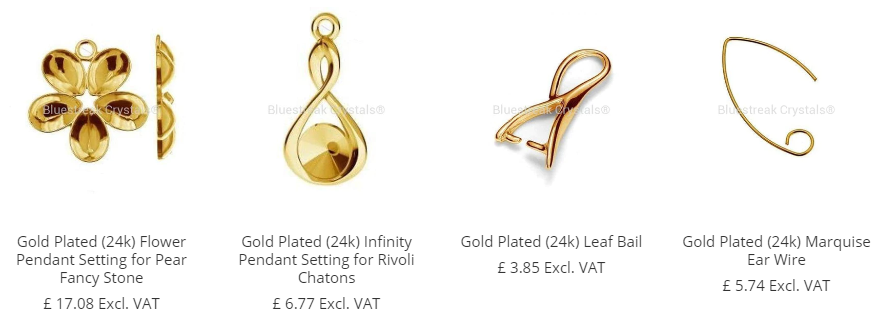Your Cart is Empty
Menu
-
- Brands
- Beads
- Flat Backs
- Pearls
- Pendants
- Sew On
- Stones
- Trimmings
- Accessories
- Gifts
- Resources
-
- UK: 0800 464 7313 | INT: +44 1494 578708
- Login
-
United Kingdom (GBP £)

Tips for Sourcing Reliable Jewelry Findings
January 24, 2024 4 min read

When it comes to artisan jewelry making, the importance of reliable jewelry findings simply cannot be overstated; these small but essential components are the backbone of any piece of jewelry, ensuring both its functionality and aesthetic appeal. But how can you find reliable, high quality jewelry findings as an independent jewelry maker? In this guide, we’re going to take a look at some of the nuances of sourcing high-quality jewelry findings, while giving you some valuable insights, whether you’re a novice or an experienced jewelry maker.
Understanding the Importance of Quality Findings
The Foundation of Jewelry Integrity
Quality findings are crucial for the longevity and wearability of jewelry; put simply, they’re the connecting pieces that hold jewelry together, and their strength and durability directly impact the overall quality of the piece. High-quality findings not only enhance the visual appeal but also ensure that the jewelry remains secure and comfortable to wear. If you want to learn more about the subject, you can learn about jewelry findings here over on our blog.
Impact on Aesthetic and Value
The choice of findings can also significantly influence the aesthetic and perceived value of the jewelry; well-crafted findings blend seamlessly with the design, elevating the overall look, while poor-quality findings can detract from the beauty of the precious stones and metals used.
Factors to Consider When Sourcing Jewelry Findings
Material Quality
When it comes to metals, you can find a variety of different findings both online and offline, but quality is key here; options range from precious metals like gold and silver to durable alternatives like stainless steel and titanium. Consider the compatibility of the findings' material with the overall design and the type of jewelry being created before settling on a metal.
Supplier Reputation
Choosing a reputable - and most importantly, reliable - supplier is another highly important element here; research suppliers thoroughly, and seek out those with a history of providing high-quality findings - such as us at Bluestreak Crystals. Look for reviews, testimonials, and industry recommendations to gauge their reliability.
Types of Jewelry Findings and Their Attributes
So, what exactly is a jewelry finding?
Clasps and Closures
First up are clasps; clasps are vital for the functionality of necklaces and bracelets, and come in various styles such as lobster clasps, magnetic clasps, and toggle clasps, each offering different levels of security and ease of use.
Earring Components
Earring findings, such as hooks, posts, and hoops, also determine the style and comfort of earrings; the choice of component really depends on the earring design and the wearer's preferences, but hooks and posts are both incredibly common.
Connectors and Jump Rings
Connectors and jump rings are the unsung heroes of jewelry making, providing flexibility in design while also ensuring the structural integrity of the piece.
Tips for Effective Sourcing of Jewelry Findings
Establishing Quality Standards
Before sourcing, establish clear quality standards for your findings; this includes specifying the grade of metal, the type of finish, and the overall craftsmanship. Consistent quality standards ensure that each piece of jewelry maintains a high level of excellence and durability.
Building Relationships with Suppliers
Developing strong relationships with suppliers can be highly beneficial, especially if you’re running an online store and need to be able to keep up with demand. Good rapport often leads to better pricing, access to higher quality materials, and more reliable service, so don’t hesitate to communicate your specific needs and preferences - many suppliers will be more than willing to accommodate custom requests.
Sampling and Testing
Top tip: always request samples before committing to a large order. This allows you to physically assess the quality and suitability of the findings for your specific projects - you can conduct tests to check for strength, colorfastness, and compatibility with other materials you use.
Diversifying Sources
Finally, relying on a single supplier can be risky, which is why diversifying your sources can help you mitigate supply chain disruptions while also exploring a wider range of aesthetic options. This approach also allows you to compare quality and prices, ensuring you get the best value for your investment, so don’t hesitate to shop around.
The Bottom Line
Overall, the process of sourcing reliable jewelry findings can be lengthy, but it’s a vital step if you want to be able to make durable, valuable and aesthetically pleasing jewelry. Equipped with a better understanding of the importance of quality findings, you’ll be sure to significantly enhance the value and appeal of your jewelry pieces.
FAQs
What are the most durable materials for jewelry findings?
The most durable materials for jewelry findings include stainless steel, titanium, and precious metals like gold, silver, and platinum, as these metals are known for their strength, longevity, and resistance to tarnish and corrosion.
How can I ensure the findings I source are hypoallergenic?
To ensure hypoallergenic findings, opt for materials like surgical stainless steel, titanium, and 14K gold or higher. Avoid nickel and brass, as they are common allergens, and always check with your supplier about the hypoallergenic properties of their products.
Can the quality of findings affect the overall value of my jewelry?
Yes, the quality of findings can significantly impact both the aesthetic and functional value of your jewelry; high-quality findings enhance durability, wearability, and overall appeal, which can increase the perceived value of your pieces.
Is it better to buy findings in bulk or in smaller quantities?
This depends on your specific needs; buying in bulk often results in cost savings and ensures you have a consistent supplier, however for unique or specialized projects, smaller quantities might be more practical to avoid excess inventory.

